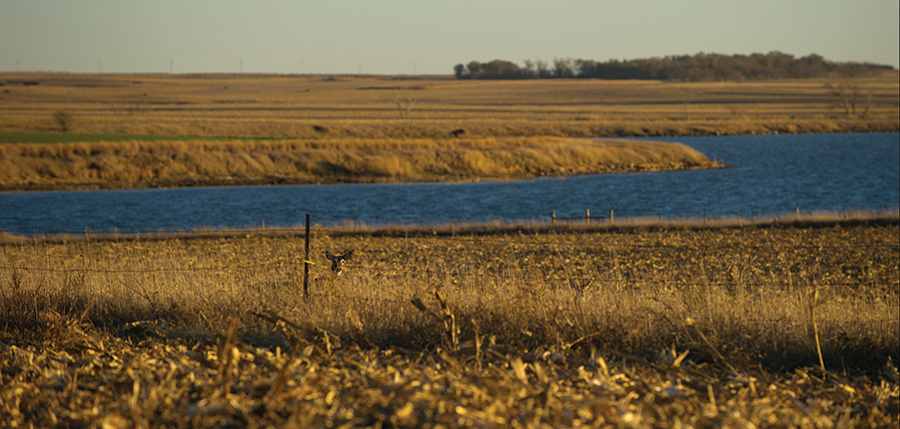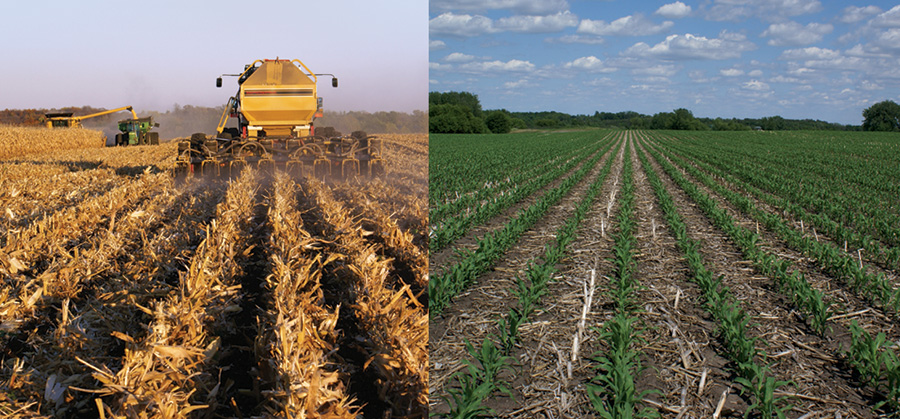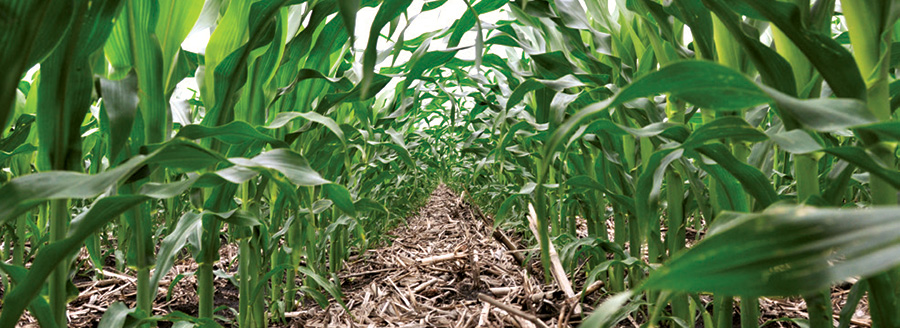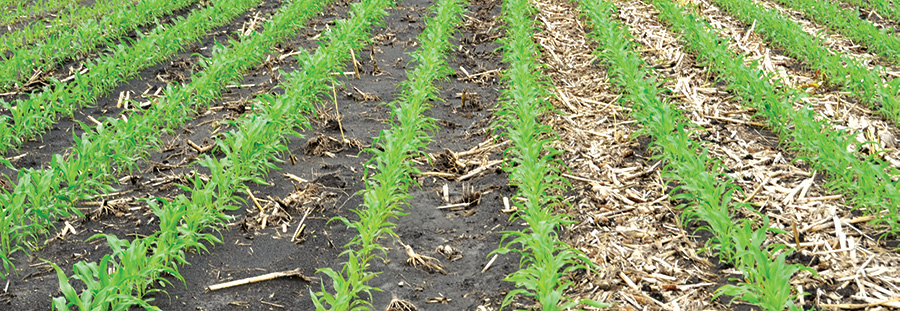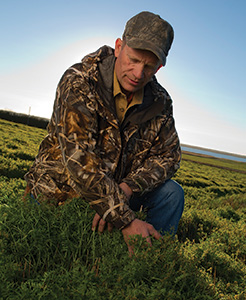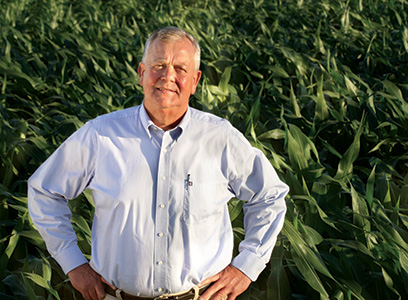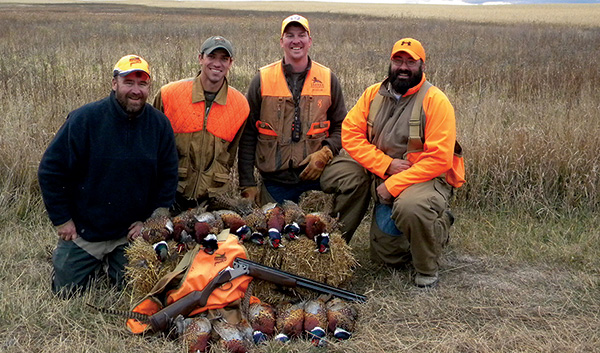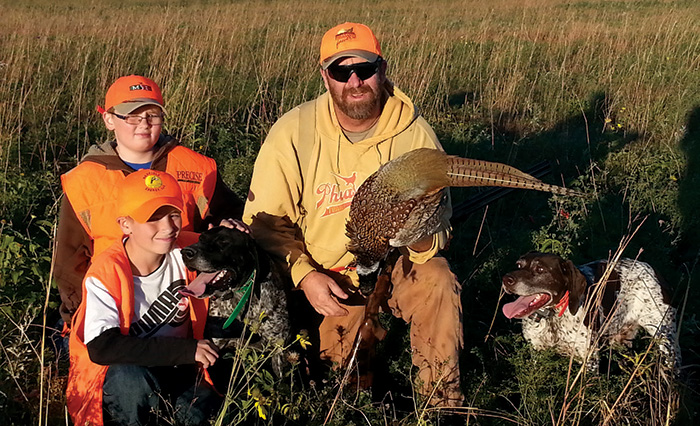The young boy hopped and skipped across ground farmed by his family for generations, his dog trotting along behind him. Strips of thick cornfield stubble forced him to slow enough to maneuver over the rows before he encountered another strip of smoother ground again. His father had explained the strips, but his mind wandered elsewhere to the edge of thick grass and low trees that cut through the field only a few yards away. His raucous arrival at its edge was enough to spur the sudden flapping of wings. A pheasant jetted from the tall grass, startling him for a moment before the familiar roar of a diesel engine begged his attention and beckoned him back to the farmstead.
Creating idyllic scenes like this, where cropland gives way purposefully to wildlife habitat, are becoming more of the norm. In places where fences were once torn out to ensure more ground could be worked is now being turned into wildlife habitat. The use of sustainable farming practices are partnering highly productive crop production with environmental stewardship. It’s a serious balancing act that continues to play out across America’s heartland – and its success or failure will have lasting impacts for both agriculture and the environment.
For decades, farmers found themselves in a tug-of-war between consumers who demanded low grocery bills, and environmentalists and regulatory agencies demanding significant change.
Now criticism of agriculture has begun to boil over, and it’s no longer just the fringe groups sounding the alarm. Demons like agricultural runoff, improper use of chemicals, poor cropping techniques that rob soil of nutrients and other environmental harms continue to haunt the agriculture industry even as many farmers turn to the use of sustainable practices.
While it is typically high-input, conventional agriculture grabbing the headlines for all the wrong reasons, the bigger story unfolding in production agriculture today is the movement toward no-till and low-input farming.
So, with the demand from a growing population and increased use of biofuels, is it possible for modern agriculture and increased production of corn to coexist with sustainability – without putting soil quality and habitat for wild life at risk?
The simple answer – yes.
Today’s farmers are finding a variety of ways for production agriculture – even on a large scale – to work in harmony with the natural environment. And what may be surprising to some: they aren’t giving up profits or yields to do so. Over the next few pages, Vital gives you a few examples of equipment companies and farmers that have embraced sustainable practices without sacrificing their bottom line.
PRECISION AGRICULTURE MEETS NO-TILL
One of the ways farming is becoming more sustainable without sacrifice in productivity is with the use of low-inputs and precision agriculture techniques. Craig Hiemstra, Vice President of Marketing and Sales for Environmental Tillage Systems, Inc., points out that environmental tillage systems are growing in popularity among farmers, a sign that more are embracing sustainable farming practices, even on large-scale operations.
Field shown during fall harvest and again the following spring.
Environmental Tillage Systems, Inc. (ETS) manufactures conservation tillage and nutrient management equipment designed to improve soil productivity and farm profitability. Since its beginnings in 2004 on a farm in southeastern Minnesota, the company has grown to reach customers in the U.S., Canada, Australia and New Zealand.
One example of sustainable equipment is the SoilWarrior, a flagship piece of equipment Hiemstra says acts like primary and secondary tillage implements all rolled into one.
“This one machine provides all the environmental benefits of strip tillage,” he explains. “The SoilWarrior helps save soil, labor, moisture and fuel while optimizing fertilizer efficiency.”
The SoilWarrior is designed to be a shallow tillage system, creating an aerated seedbed that is warm, dry and inviting for quick germination and early plant growth. Hiemstra says the SoilWarrior environmental tillage equipment also exhibits unprecedented soil management.
The SoilWarrior can also be used to band nutrients and create a fertile zone for strong early growth and sustained development. It minimizes compaction, supports conservation of soil and water resources, and saves both time and money, according to the manufacturer.
He credits development of the SoilWarrior with invention of the zone tillage concept, which keeps soil where it belongs – in the field.
“It does this by maintaining the root structure between each tilled zone and incorporating residue into the growing zone.”
High input costs have generated more interest in SoilWarrior because of the savings it offers by combining fertilizer placement with fall or spring tillage. Farmers are finding that it saves fuel and labor, while improving yield potential and extending the planting window.
In addition, SoilWarrior is appealing to farmers who have been working with local precision farming specialists and having zone tillage custom-applied for a contracted fee per acre. Of course, the new environmental tillage systems are also appealing to farmers who are good soil conservationists and desire to pass along a farm with good soil health to the next generation.
Ted Frank says his family’s operation eased into the use of environmental tillage systems. He farms in partnership with his wife, Kim; son Tom; brother Ed; and sister-in-law Cindy, as well as a full-time employee. The 1,000-acre operation in Mower County, Minn., is a farrow-to-finish hog enterprise that produces about 7,000 market hogs annually.
“We rented an eight-row SoilWarrior in 2011 and again in 2012, to learn about and evaluate the system,” Frank recalls. “We purchased our own machine in the fall of 2012.”
Their goals for reducing soil erosion and increasing productivity through better nutrient placement are the primary reasons they became interested in strip till. Use of the SoilWarrior has just been one step in their route to more sustainable farming practices.
“Another change we have made is to allow our manure application to work with our strip till system by purchasing a vertical tillage injection bar for our manure tank, and adding a flow meter, monitor system and auto steer,” he says. “The new equipment allows us to have control over manure rates and apply manure with minimal soil disturbance.”
The Frank family isn’t the only ones turning to environmental tillage systems. Benjamin Pederson farms about 3,000 acres of corn and soybeans with his father, Gary.
“Nearly 10 years ago, a seed was planted in my brain that we could do things better than how we were doing them,” Pederson relates. “Typical for our area, we were either disk-ripping cornstalks or moldboard plowing them. It was common for us to plow the acres that were to be corn-on-corn and rip the acres that were to be soybeans the following year.”
In both cases, they would run a stalk chopper over every corn acre to help with residue decomposition. Even on soybean stubble, they would perform some sort of light tillage in the fall. In the spring this was followed by one, or even two, field cultivator passes prior to planting.
Ben Pederson in his SoilWarrior zoning his farm.
“Fields and road ditches were black all winter. It was in examining the soil after all that tillage that I began to search for a better way. Even though there was three inches of loose soil making a good seed bed over most of the surface, the wheel tracks were always cloddy and hard, while over the rest of the implement width, there was a hard, smear layer at field cultivator sweep depth,” he recalls.
Then, there was the erosion. Almost every year, utilizing even more tillage, they would have to smooth out areas were water had taken the loose, unanchored soil and cut ravines and gullies on the rolling terrain.
“While I knew even in my youth that this was not at all desirable, it was thought of as an unavoidable loss, because of the prevailing conventional wisdom in northern latitudes like ours, where we get fewer growing degree units per year than most in the corn belt and we have some black soil with drainage problems,” he recalls. “Most of the older generations of farmers believed the only way around these problems was tillage, exposing the black soil to the elements to warm and dry it.”
As he pondered these issues, a practice called strip till came to his attention and the idea immediately struck a chord.
“Tillage right where you need it and nowhere else, and fertilizer right were you need it,” he remembers hearing.
At about the same time, he joined with some local farmers roughly his age in a running dialogue on soil, discussing what was beneficial and what was detrimental.
“The bottom line was this: tillage, most often, is detrimental to soil,” Pederson explains. “In 2011, after researching different machines and speaking with owners of different equipment – and building up a significant amount of courage – I made the decision to purchase a SoilWarrior.”
The system offered them a way to avoid fall nitrogen fertilization, which can be subject to significant loss, and apply it precisely where corn will be grown and incorporate it into the soil.
“My goals in utilizing SoilWarrior to perform strip till are simply to address all the issues I saw with our conventional way of farming,” explains Pederson. “While about 1,500 of my dad’s acres are still farmed that way, he has begun to have me strip till a great many other acres. The good part about this process is that we get to compare the differences. In 2012, two of our top three yielding corn farms were strip tilled. Soybeans yields also compared favorably, in about a dead heat.”
Pederson says another advantage SoilWarrior offers is the ability to strip till corn-on-corn without plugging with residue. He also saw an advantage this past fall when the machine was able to run in non-ideal, wet conditions while other farmers with shank machines could not do so.
“That is a big deal in November when most likely things are not going to dry out again,” he adds.
Black horizontal/conventional tillage versus environmental/strip tillage.
A record-wet spring in 2013 put sustainable tilling to the test as well. Many acres near Pederson did not get planted and those that did, had massive bare spots at harvest due to crop loss from all the excess water.
“That spring allowed us to really test that old farmer mentality of tillage overcoming cold, wet weather. Ultimately, when we really needed to plant crops in wet conditions, we were able to plant in the strips easier than the conventional tillage,” he says. “Because we had that black, narrow strip, the sun did its work and dried off that top layer enough so the planters would work. In between rows, the soil was structured well enough with old root mass, organic matter, and earthworm burrows that we did not sink, get stuck or spin nearly as often.”
But without showing any improvement in yield – regardless of field conditions – does Pederson still see an advantage to an environmental tillage system?
“Some may think that because yields have not significantly increased yet, the system has failed. That could not be further from the truth,” he explains. “Because of savings in fuel, machine wear and tear, labor, and soil, a tie is actually a win.”
As soils continue to build organic matter, natural structure, and tilth, farmers are likely to see yield increase over time. With just two full seasons under their belt with strip till, Pederson and his father are just getting the ball rolling on sustainable farming practices. One new step he’s taken is to plant a cover crop designed to increase soil health on all acres under prevented plant status. Happy with the results, he is anxious to identify ways to incorporate cover crops more regularly.
“To me, sustainability begins and ends in the soil,” Pederson adds. “As long as we have fertile topsoil everywhere it should be, we can grow things to feed humanity. Without it, we simply cannot. That is where our focus is.”
CONSERVING THE LAND FOR GENERATIONS
Caring for the soil was also the catalyst for Dave Gillen’s interest in sustainable farming practices, although like the others, he sees his bottom line entering the picture as well. Since 1990, he and his wife, Carol, have been farming with notill and reduced tillage on their corn, soybean and wheat operation in south-central South Dakota, about 100 miles west of Sioux Falls. The farm has been in the family since 1897.
Dave Gillen
“The biggest reason we moved away from all the tillage was profitability and soil health. We have significantly increased soil organic matter through the years from the reduced tillage, which makes healthier soil and conserves moisture the crops use,” he says.
The Gillens are also mindful of providing a place for wildlife, using marginal land for pheasant habitat. They rotate crops and use cover crops.
“Our best rotation is corn, beans, corn, beans, wheat and plant a cover crop after the wheat,” explains Dave. “This five-year rotation fits our area and spreads risk across multiple crops. Having 20 percent of the farm planted to wheat disrupts plant disease cycles of the other crops, spreads out our workload, and provides nesting habitat for pheasants. Wheat also gives us a window after harvest to plant cover crops to grow in August through October.”
Crop-residue cover year-round is another important component of their operation. With reduced tillage, the plant material remains on the soil surface after harvest. This crop residue provides a place for beneficial insects to over winter, protects soil from wind and water erosion, provides the best environment for increasing beneficial earthworm populations, and keeps the soil temperature cooler for less stress on the plant root system during the heat of the summer.
With eight inches of topsoil in his area, Gillen says they have none to lose. No-till and cover crops add topsoil over time.
“All the while, we are growing crops for food and energy,” he says. “Profitable, sustainable agriculture creates new wealth for everyone to prosper and leaves the land in better condition so future generations can utilize it.”
LARGE-SCALE SUSTAINABILITY SUCCESS
Western Illinois grain farmer Jim Purlee agrees that sustainable farming does not have to mean reduced yields or profitability. The Galesburg-area operator runs about 9,600 acres of corn and soybeans, tracing his start in farming back to 1975, when he purchased his original 80 acres.
Jim Purlee
Purlee’s nephew farms with him and he also employs four other full-time employees, with another 12 part-time employees during fall harvest. The operation includes eight semis and 1.5 million bushels of grain storage.
“Employees haul corn all winter to the Big River ethanol plant in Galva,” Purlee says.
He planted his first no-till soybeans back in 1986. Two years later, the operation was 100 percent no-till for both corn and soybeans.
“Our five-year corn average is 208 bushes per acre and beans are 58,” Purlee states. Even in the 2012 drought, corn averaged 204 bushels per acre with one farm at 226.
While some may be hesitant to jump into sustainable farming methods, Purlee says he believes no-till has solved a lot of problems.
“We tile as needed and reseed grass waterways as needed. We don’t have the water runoff and soil erosion that you have with tillage,” he explains. “No-till is so simple and good for the soil, I really can’t understand why everyone doesn’t use it.”
Worries over cost are likely unfounded, as Purlee points out there is no costly additional equipment to invest in, just the substitution of no-till equipment for a host of plows and cultivators. Not following conventional tillage practices also saves on fuel.
FARMING WITH PHEASANTS FOREVER
Even farmers convinced that notill and other sustainable practices can be profitable may be surprised to learn that conserving marginal land and establishing wildlife habitat does not have to be a costly investment, either.
Farm Bill Biologist team on the Ristau Farm - Jim Ristau, Jamison Winter, Mike Blaalid, Matt Morlock
Jim Ristau is a Farm Bill biologist with Pheasants Forever. The Farm Bill biologist program began in South Dakota in 2003, with the goal of placing wildlife biologists in USDA offices to assist landowners with habitat development, maintenance and enhancement, as well as to promote wildlife-friendly farming practices.
Ristau uses his expertise on wildlife habitats, coupled with knowledge of state and federal programs, to improve communication with landowners on increasing conservation practices.
The Pheasants Forever Farm Bill biologist program has evolved into 110 positions in 18 states, and has impacted over 3.5 million acres. Ristau says Pheasants Forever believes there is room for improving conservation on every farm.
“By working with landowners, often through on-site evaluation, we are able to identify problem areas and consider viable options for dealing with marginal land,” explains Ristau. “Many times, there are cost-share programs to assist farmers. Marginal areas can also be very useful as high-quality wildlife habitat.”
Ristau grew up on a farm near Aberdeen, S.D., with a passion for hunting, fishing and wildlife.
“The farm originally consisted of about 2,100 acres that were farmed by my grandfather. He was concerned about conservation, after the Dust Bowl years, and planted some of the first field windbreak shelterbelts in that area.”
After passing through the hands of his father and uncle, the family farm is now being operated by Ristau’s younger brother, David, who utilizes a variety of sustainable farming practices and has utilized all no-till farming practices since 2000. He maintains about 100 acres of cover crops annually to provide additional grazing benefits and build soil fertility.
Soil tests and yield data are used to make informed decisions regarding input investments.
“He tries to maintain every drop of water that falls upon his land by maintaining wetlands areas and improving soil structure,” adds Jim Ristau. “David moves cattle to aftermath cropland and cover crop areas for grazing. He uses ethanol by-products to feed calves for several months post-weaning to improve gain, which also reduces feed costs. All these practices are wildlife-friendly and good for the environment. They minimize input costs, so profitability increases. Not to mention, runoff is minimized and soil health is maintained.”
Conservation areas also provide nesting and brood-rearing habitat for many species of birds. In drier years, crop yields have remained comparatively stable due to increased soil structure and water holding capacity of the soils. Weeds and pests are effectively managed through proven rotations, reducing chemical and fertilizer needs.
Currently, the farm has about 900 acres in a corn/bean/wheat rotation. David Ristau raises about 150 cows and calves each year, with an additional 850 acres in pasture, hay and native range. About 160 acres are in the Conservation Reserve Program, with the remaining non-crop acres primarily native wetlands, wetland buffers, headquarters and shelterbelts.
“Additionally, wildlife resources are created and maintained, in concert with ag production,” Ristau says of the farm. “Annual pheasant harvest, done by family and friends, is usually around 250 wild birds.”
The land is also home to a healthy deer population, providing trophy-quality bucks, and offers opportunities for a local trapper as well, further testament to the wildlife diversity of the farm.
“Collectively, all this helps maintain a stable income, a high quality of life, and high quality outdoor experiences with family and friends,” he says.
Archery deer taken on Ristau Farm - Jim Ristau
Ristau says while there may be some upfront investment with sustainable practices, there are also tradeoffs where savings can be found.
“Payback is realized by maintaining diversity, which over time improves profitability and reduces risk,” Ristau says. “By taking marginal lands out of production, or using them instead as conservation areas, risk is reduced by providing a stable alternative to dealing with weather events or price swings, like we see today.”
Farmers are likely to find that just taking low-yield areas out of production will reduce losses in many cases. Taking advantage of USDA’s conservation reserve program (CRP) can provide a stable income on such land.
“Sustainability can mean many different things, but in my opinion, it means leaving the land in better condition than when we started,” Ristau says. “Anything less is unsustainable. If we are not building soils, we are depleting them. That is how deserts are formed. Science and technology will always tell us how to do this better, and it should be embraced, but to do this in a sustainable fashion should be every land manager’s goal.”
Ristau predicts that long-term, it is the only way U.S. agriculture will remain the global leader for food production.
“Diverse and sustainable farming and ranching will allow society to maintain strong and vibrant rural communities, economies and lifestyles,” he says.
Pederson agrees. “Mostly, economics aside, the deeper I get into my study of soil conservation and health, the more dedicated I am to preserving this land that was passed to me from generations before, to countless generations after me. I think it is truly the responsible and moral choice,” he adds.
2013 pheasant opener on Ristau Farm - Gunner and Garret (11 year-old twins) with their father, Jim Ristau
